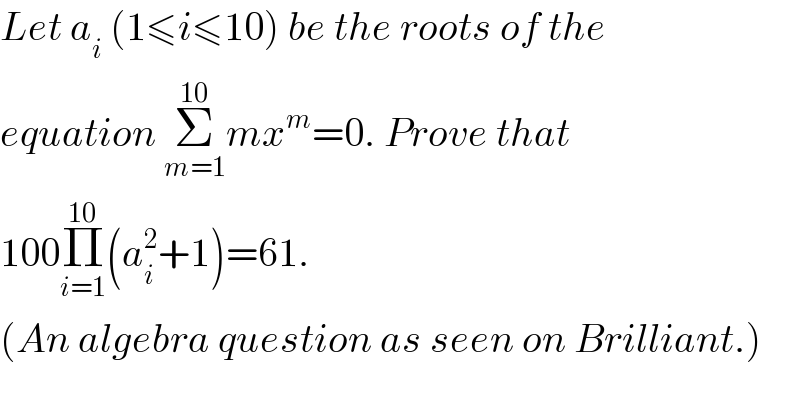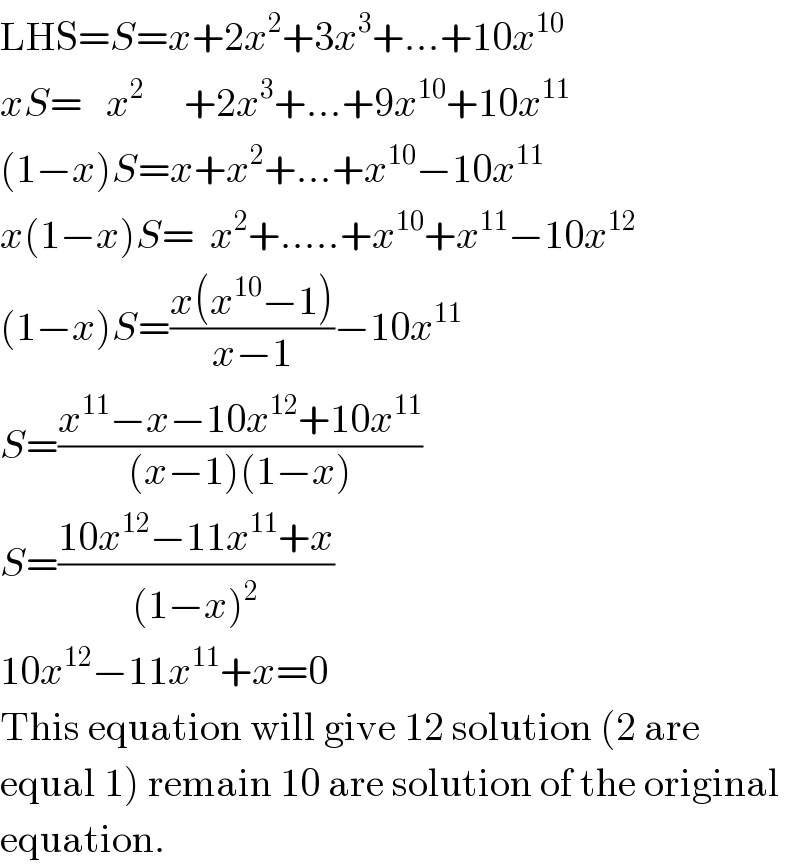
Question Number 3775 by Yozzii last updated on 20/Dec/15

$${Let}\:{a}_{{i}} \:\left(\mathrm{1}\leqslant{i}\leqslant\mathrm{10}\right)\:{be}\:{the}\:{roots}\:{of}\:{the} \\ $$$${equation}\:\underset{{m}=\mathrm{1}} {\overset{\mathrm{10}} {\sum}}{mx}^{{m}} =\mathrm{0}.\:{Prove}\:{that} \\ $$$$\mathrm{100}\underset{{i}=\mathrm{1}} {\overset{\mathrm{10}} {\prod}}\left({a}_{{i}} ^{\mathrm{2}} +\mathrm{1}\right)=\mathrm{61}. \\ $$$$\left({An}\:{algebra}\:{question}\:{as}\:{seen}\:{on}\:{Brilliant}.\right) \\ $$
Commented by prakash jain last updated on 20/Dec/15

$$\mathrm{LHS}={S}={x}+\mathrm{2}{x}^{\mathrm{2}} +\mathrm{3}{x}^{\mathrm{3}} +...+\mathrm{10}{x}^{\mathrm{10}} \\ $$$${xS}=\:\:\:{x}^{\mathrm{2}} \:\:\:\:\:+\mathrm{2}{x}^{\mathrm{3}} +...+\mathrm{9}{x}^{\mathrm{10}} +\mathrm{10}{x}^{\mathrm{11}} \\ $$$$\left(\mathrm{1}−{x}\right){S}={x}+{x}^{\mathrm{2}} +...+{x}^{\mathrm{10}} −\mathrm{10}{x}^{\mathrm{11}} \\ $$$${x}\left(\mathrm{1}−{x}\right){S}=\:\:{x}^{\mathrm{2}} +.....+{x}^{\mathrm{10}} +{x}^{\mathrm{11}} −\mathrm{10}{x}^{\mathrm{12}} \\ $$$$\left(\mathrm{1}−{x}\right){S}=\frac{{x}\left({x}^{\mathrm{10}} −\mathrm{1}\right)}{{x}−\mathrm{1}}−\mathrm{10}{x}^{\mathrm{11}} \\ $$$${S}=\frac{{x}^{\mathrm{11}} −{x}−\mathrm{10}{x}^{\mathrm{12}} +\mathrm{10}{x}^{\mathrm{11}} }{\left({x}−\mathrm{1}\right)\left(\mathrm{1}−{x}\right)} \\ $$$${S}=\frac{\mathrm{10}{x}^{\mathrm{12}} −\mathrm{11}{x}^{\mathrm{11}} +{x}}{\left(\mathrm{1}−{x}\right)^{\mathrm{2}} } \\ $$$$\mathrm{10}{x}^{\mathrm{12}} −\mathrm{11}{x}^{\mathrm{11}} +{x}=\mathrm{0} \\ $$$$\mathrm{This}\:\mathrm{equation}\:\mathrm{will}\:\mathrm{give}\:\mathrm{12}\:\mathrm{solution}\:\left(\mathrm{2}\:\mathrm{are}\right. \\ $$$$\left.\mathrm{equal}\:\mathrm{1}\right)\:\mathrm{remain}\:\mathrm{10}\:\mathrm{are}\:\mathrm{solution}\:\mathrm{of}\:\mathrm{the}\:\mathrm{original} \\ $$$$\mathrm{equation}. \\ $$
Commented by Yozzii last updated on 20/Dec/15

$${Yes}.\: \\ $$
Commented by Yozzii last updated on 20/Dec/15

$${Have}\:{you}\:{considered}\:{finding}\:{a}\:{polynomial} \\ $$$${with}\:{roots}\:{u}_{{i}} ={a}_{{i}} ^{\mathrm{2}} +\mathrm{1}\:\left(\mathrm{1}\leqslant{i}\leqslant\mathrm{10}\right)?\:{Of}\:{course}, \\ $$$${you}\:{can}\:{factorise}\:{the}\:{D}−\mathrm{12}\:{polynomial} \\ $$$${to}\:{yield}\:{a}\:{single}\:{D}−\mathrm{11}\:{polynomial}. \\ $$
Commented by Yozzii last updated on 20/Dec/15

$${Why}\:{was}\:{root}\:{of}\:{the}\:{form}\:{a}_{{i}} \pm{i}\:{chosen}? \\ $$$${Because}\:\left({a}_{{i}} +{i}\right)\left({a}_{{i}} −{i}\right)={a}_{{i}} ^{\mathrm{2}} +\mathrm{1}?\: \\ $$$${Interesting}! \\ $$
Commented by prakash jain last updated on 20/Dec/15

$$\mathrm{Correct}.\:\left({a}_{{i}} ^{\mathrm{2}} +\mathrm{1}\right)=\left({a}_{{i}} +{i}\right)\left({a}_{\mathrm{2}} −{i}\right) \\ $$$$\mathrm{So}\:\mathrm{chose}\:\mathrm{to}\:\mathrm{creat}\:\mathrm{two}\:\mathrm{different}\:\mathrm{equation} \\ $$$$\mathrm{with}\:\mathrm{roots}. \\ $$
Commented by prakash jain last updated on 20/Dec/15
![Thanks.Trying equation with root a_i +i and a_i −i 10x^(12) −11x^(11) +x=0 10(x+i)^(12) −11(x+i)^(11) +(x+i)=0 ...(A) product of roots=((10i^(12) −11i^(11) +i)/(10))=((10+12i)/(10)) 10(x−i)^(12) −11(x−i)^(11) +(x−i)=0 ...(B) product of roots=((10i^(12) +11i^(11) −i)/(10))=((10−12i)/(10)) Π_(i=1) ^(10) (a_i ^2 +1)=((product of root of A×product of root of B)/((1+i)^2 (1−i)^2 [divide by extra roots from(x−1)^2 ])) =((10−12i)/(10))×((10+12i)/(10))×(1/2^2 )=((244)/(100×4))=((61)/(100))](Q3786.png)
$$\mathrm{Thanks}.\mathrm{Trying}\:\mathrm{equation}\:\mathrm{with}\:\mathrm{root}\:{a}_{{i}} +{i}\:{and}\:{a}_{{i}} −{i} \\ $$$$\mathrm{10}{x}^{\mathrm{12}} −\mathrm{11}{x}^{\mathrm{11}} +{x}=\mathrm{0} \\ $$$$\mathrm{10}\left({x}+{i}\right)^{\mathrm{12}} −\mathrm{11}\left({x}+{i}\right)^{\mathrm{11}} +\left({x}+{i}\right)=\mathrm{0}\:\:\:...\left({A}\right) \\ $$$${product}\:{of}\:{roots}=\frac{\mathrm{10}{i}^{\mathrm{12}} −\mathrm{11}{i}^{\mathrm{11}} +{i}}{\mathrm{10}}=\frac{\mathrm{10}+\mathrm{12}{i}}{\mathrm{10}} \\ $$$$\mathrm{10}\left({x}−{i}\right)^{\mathrm{12}} −\mathrm{11}\left({x}−{i}\right)^{\mathrm{11}} +\left({x}−{i}\right)=\mathrm{0}\:\:\:...\left(\mathrm{B}\right) \\ $$$${product}\:{of}\:{roots}=\frac{\mathrm{10}{i}^{\mathrm{12}} +\mathrm{11}{i}^{\mathrm{11}} −{i}}{\mathrm{10}}=\frac{\mathrm{10}−\mathrm{12}{i}}{\mathrm{10}} \\ $$$$\underset{{i}=\mathrm{1}} {\overset{\mathrm{10}} {\prod}}\left({a}_{{i}} ^{\mathrm{2}} +\mathrm{1}\right)=\frac{\mathrm{product}\:\mathrm{of}\:\mathrm{root}\:\mathrm{of}\:\mathrm{A}×\mathrm{product}\:\mathrm{of}\:\mathrm{root}\:\mathrm{of}\:\mathrm{B}}{\left(\mathrm{1}+{i}\right)^{\mathrm{2}} \left(\mathrm{1}−{i}\right)^{\mathrm{2}} \:\left[{divide}\:{by}\:{extra}\:{roots}\:{from}\left({x}−\mathrm{1}\right)^{\mathrm{2}} \right]} \\ $$$$=\frac{\mathrm{10}−\mathrm{12}{i}}{\mathrm{10}}×\frac{\mathrm{10}+\mathrm{12}{i}}{\mathrm{10}}×\frac{\mathrm{1}}{\mathrm{2}^{\mathrm{2}} }=\frac{\mathrm{244}}{\mathrm{100}×\mathrm{4}}=\frac{\mathrm{61}}{\mathrm{100}} \\ $$
